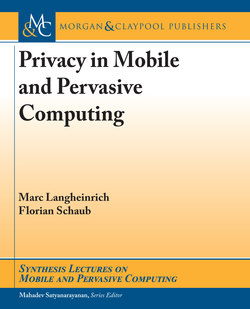Читать книгу Privacy in Mobile and Pervasive Computing - Florian Schaub - Страница 8
На сайте Литреса книга снята с продажи.
ОглавлениеPreface
In this book, we dissect and discuss the privacy implications of mobile and pervasive computing technology. For this purpose, we not only look at how mobile and pervasive computing technology affects our expectations of—and ability to enjoy—privacy, but also look at what constitutes “privacy” in the first place, and why we should care about maintaining it. The book is structured as follows.
• Chapter 1: Introduction. This short chapter motivates the need for this book and outlines its contents.
• Chapter 2: Understanding Privacy. This chapter offers an in-depth discussion on what privacy is, i.e., what it means to “have privacy”, and why we may want and need privacy. It does so by examining the concept of privacy from three perspectives: legal perspectives on privacy (also with a view towards their historic context); motivations for having (or not having) privacy; and more general conceptualizations of privacy. These perspectives support assessment of the often nuanced privacy implications of new technologies.
• Chapter 3: Mobile and Pervasive Computing (MPC). This chapter summarizes the key defining characteristics of mobile and pervasive computing. While mobile and pervasive computing systems feature privacy issues inherent in any computer system in general (e.g., interconnectivity), aspects such as context awareness and implicit interaction pose new privacy challenges unique to mobile and pervasive computing.
• Chapter 4: Privacy Implications of MPC. This chapter explores the specific privacy implications of mobile and pervasive computing in order to determine the challenges that must be addressed in order to create more privacy-friendly mobile and pervasive computing systems. It groups these around three core aspects: (1) the digitization of everyday life; (2) the ability of automatic data capture; and (3) the ability of using data to predict behavior. While none of these trends are new, mobile and pervasive computing systems exacerbate these issues greatly.
• Chapter 5: Supporting Privacy in MPC. This chapter discusses seven key directions and associated challenges for building privacy-friendly mobile and pervasive computing systems: (1) privacy-friendly defaults; (2) adequate privacy-risk communication; (3) privacy management assistance; (4) context-adaptive privacy mechanisms; (5) user-centric privacy controls; (6) algorithmic accountability; and (7) privacy engineering methodologies. While there is no silver bullet to remedy all privacy implications of any mobile and pervasive computing system, the presented approaches constitute an essential toolbox for building privacy into mobile and pervasive computing systems.
• Chapter 6: Conclusions. This chapter provides a brief outlook and stipulates key challenges for privacy that the authors see.
FOCUS AND AUDIENCE OF THIS BOOK
This book is intended as a brief introduction into the multidisciplinary area of privacy research, with a focus on its applicability to mobile and pervasive computing systems. The presented material is not meant to be comprehensive—privacy research spans a vast array of scientific disciplines and research, to which this book often only provides initial pointers. However, this book should provide readers with a basic understanding of the issues, complexities, and approaches involved in building privacy-aware mobile and pervasive computing systems.
The prime target audience of this lecture are researchers and practitioners working in mobile and pervasive computing who want to better understand and account for the nuanced privacy implications of the technology they are creating. Armed with the knowledge in this book, we hope they will avoid opting for simple solutions that fail to address the true complexity of the problem, or even deciding not to address privacy issues at all.
At the same time, researchers working in the areas of privacy and security in general—but without a background in mobile and pervasive systems—might want to read this lecture in order to learn about the core properties and the specific privacy challenges within the mobile and pervasive computing domains.
Last but not least, graduate and undergraduate students interested in the area should be able to gain an initial overview from this book, with enough pointers to start exploring the topic in more depth.
Marc Langheinrich and Florian Schaub
October 2018
